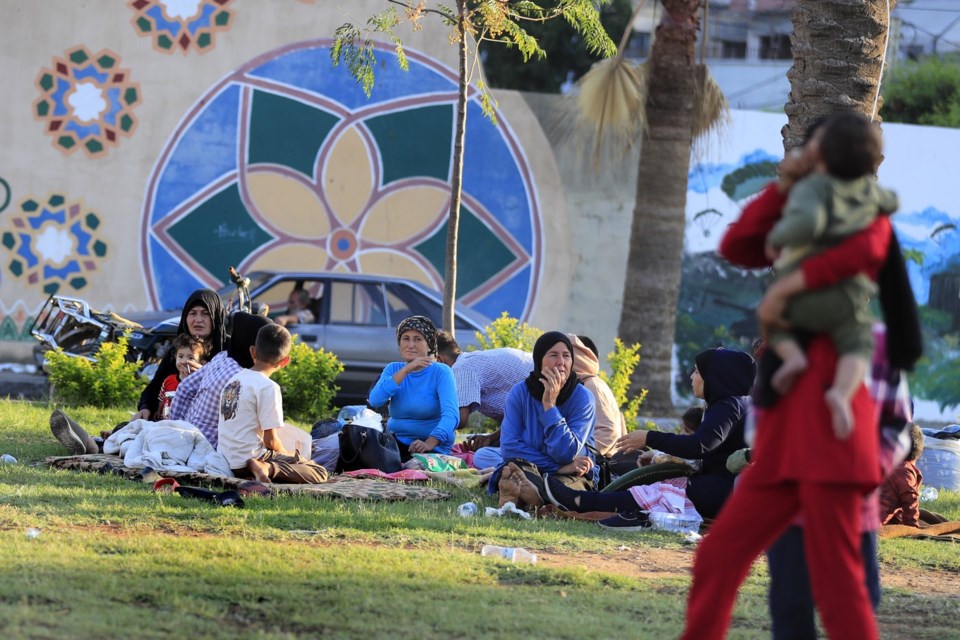BEIRUT (AP) — Israel and Hezbollah traded strikes again Tuesday, a day after a massive Israeli bombardment killed nearly 500 people, sent thousands fleeing from southern Lebanon and put the two sides .
slept in shelters hastily set up in schools in Beirut and the coastal city of Sidon. With hotels quickly booked to capacity or rooms priced beyond the means of many families, those who did not find shelter slept in their cars, in parks or along the seaside.
Well-wishers offered up empty apartments or rooms in their houses in social media posts, while volunteers set up a kitchen at an empty gas station in Beirut to cook meals for the displaced.
In the eastern city of Baalbek, the state-run National News Agency reported that lines formed at bakeries and gas stations as residents rushed to stock up on essential supplies in anticipation of another round of strikes on Tuesday.
The Lebanese militant group Hezbollah said it launched missiles overnight at eight sites in Israel, including an explosives factory in Zichron, 60 kilometers (37 miles) from the border.
The Israeli military said Tuesday morning that 55 rockets were fired from Lebanon into northern Israel, setting fires and damaging buildings. Military officials said they carried out dozens of airstrikes on Hezbollah targets, including on a cell that fired rockets overnight, and that tanks and artillery struck targets near the border.
Galilee Medical Center, a northern Israel hospital, said that two patients arrived with minor head injuries from a rocket falling near their car. Several others were being treated for light wounds from running to shelters and traffic accidents when alarms sounded.
The renewed exchange came after Monday's historic barrages racked up the in any single day in Lebanon since Israel and Hezbollah fought a bruising monthlong war in 2006.
Israel said it targeted sites where Hezbollah had stored weapons. Data from American fire-tracking satellites analyzed Tuesday by The Associated Press showed the wide range of Israeli airstrikes aimed at southern Lebanon, covering an area of over 1,700 square kilometers (650 square miles).
NASA’s Fire Information for Resource Management System typically is used to track wildfires across rural areas of the U.S. However, it can also be used to track the flashes and burning that follow airstrikes. That’s particularly true when an airstrike ignites flammable material on the ground, such as munitions or fuel.
Data from Monday showed significant fires breaking out across southern Lebanon and in the Bekaa Valley. Several areas showed intense, multiple fires, including near the southern coastal town of Naqoura, which hosts a base for the U.N. peacekeeping mission in southern Lebanon known as UNIFIL. Others were in mountainous rural areas or villages.
The sides appear again after tensions have steadily escalated over the last 11 months. Hezbollah has been firing rockets, missiles and drones into northern Israel in solidarity with the Palestinians and its ally Hamas, a fellow Iran-backed militant group, .
Israel has responded with increasingly heavy airstrikes and the targeted killing of Hezbollah commanders while threatening a wider operation.
Thousands of Lebanese on Monday after the Israeli military ordered people to evacuate areas where it accuses Hezbollah of positioning rocket launchers and other weapons, in the biggest exodus since the monthlong war waged 18 years ago.
The Lebanese Health Ministry said Monday's strikes killed 492 people, including 35 children and 58 women, and wounded 1,645 people — a staggering one-day toll for from last week.
Nearly a year of cross-border fire had already emptied out communities near the border, displacing tens of thousands of people on both sides. Israel has vowed to do whatever it takes to ensure its citizens can return to their homes in the north, while Hezbollah has said it will keep up its rocket attacks until there is a cease-fire in Gaza, .
The Israeli military says it has no immediate plans for a ground invasion but is prepared for one, after moving thousands of troops who had been serving in Gaza to the northern border. It says Hezbollah has launched some 9,000 rockets and drones into Israel since last October, including 250 on Monday alone.
The military said Israeli warplanes struck 1,600 Hezbollah targets Monday, destroying cruise missiles, long- and short-range rockets and attack drones, including weapons concealed in private homes. Lebanese officials have said many of the victims were civilians, including more than 90 women and children killed.
Israel estimates Hezbollah has some 150,000 rockets and missiles, including guided missiles and long-range projectiles capable of striking anywhere in Israel.
Monday's escalation came after a particularly heavy exchange of fire Sunday. Hezbollah launched around 150 rockets, missiles and drones into northern Israel in retaliation for strikes that killed and dozens of fighters.
Last week, thousands of communications devices, used mainly by Hezbollah members, , killing 39 people and wounding nearly 3,000, many of them civilians. Lebanon blamed Israel, but Israel did not confirm or deny responsibility.
___
Associated Press writer Jon Gambrell in Dubai contributed to this report.
___
Follow AP’s war coverage at
Abby Sewell, The Associated Press




